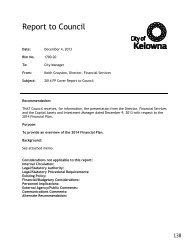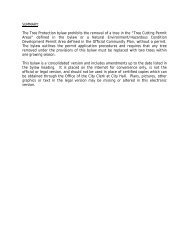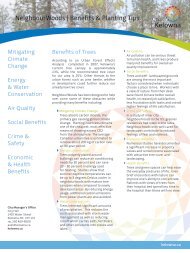Comprehensive Site Development Plan ... - City of Kelowna
Comprehensive Site Development Plan ... - City of Kelowna
Comprehensive Site Development Plan ... - City of Kelowna
Create successful ePaper yourself
Turn your PDF publications into a flip-book with our unique Google optimized e-Paper software.
Avocets at Glenmore Landfill<br />
3<br />
2.3 Potential compensation habitat at Glenmore Landfill<br />
Four sites near the Glenmore Landfill site were investigated for potential for compensation<br />
habitat. Consideration was given to natural potential <strong>of</strong> the site, potential for engineering suitable<br />
habitat, and plans for location <strong>of</strong> proposed water management facilities at the landfill. Potential<br />
sites at Glenmore Landfill included:<br />
(1) northeast meadow near the buffer zone with Quail Ridge<br />
(2) a portion <strong>of</strong> the existing south Alki Lake;<br />
(3) farm field north <strong>of</strong> the present landfill;<br />
(4) small pond near access road to landfill<br />
The northeast area was rejected because 1) the landscape is likely too confining, i.e. too close to<br />
hills for the avocet which likes open prairie-like conditions, 2) many trees would need to be cut to<br />
provide open spaces around the wetland, and 3) water management requirements suggest a deep<br />
pond will be required at that location.<br />
The farm field to the north was rejected because 1) the slope is steep and considerable earthworks<br />
would be required to engineer a flat wetland, 2) property may have to be purchased, and 3) an<br />
access road across the land has been committed to by the <strong>City</strong> <strong>of</strong> <strong>Kelowna</strong> within a 10-year time<br />
frame.<br />
The small wetland near the existing access road to the landfill was rejected because 1) avocets do<br />
not use this pond at all, probably because <strong>of</strong> disturbance from traffic and work operations, and 2)<br />
this disturbance will likely continue in the future.<br />
The south end <strong>of</strong> the Glenmore Landfill appears to <strong>of</strong>fer favourable mitigation potential because<br />
1) it is currently used by nesting American Avocets, a smaller part (but <strong>of</strong> sufficient size, -see<br />
Conservation <strong>Plan</strong>) <strong>of</strong> it could be partitioned and engineered relatively easily compared to other<br />
sites, 2) the south end <strong>of</strong> Alki Lake is furthest away from human disturbance compared to other<br />
potential sites, and 3) an evaporation-type pond at the south end <strong>of</strong> the landfill could fulfill the<br />
needs <strong>of</strong> a proposed water management system for the landfill.<br />
2.4 Potential compensation habitat elsewhere near <strong>Kelowna</strong>.<br />
Other wetlands in the <strong>Kelowna</strong> area could be altered to create breeding and feeding habitat for<br />
avocets. The most viable site for mitigation is Robert Lake, which is a short distance to the south<br />
<strong>of</strong> the Glenmore Landfill.<br />
Robert Lake has been used once for nesting by American Avocets, as 2 pairs nested there in<br />
1998 when water levels were low and exposed soil spits were present (Weir and Gyug 1999).<br />
Since avocets regularly use this wetland for foraging, and it is <strong>of</strong> a similar size to Alki Lake with<br />
sufficient shoreline for many pairs, it appears that the lack <strong>of</strong> nesting islands may prevent the<br />
regular use <strong>of</strong> Robert Lake for breeding. There are significant issues around land ownership and<br />
access to this wetland for the purposes <strong>of</strong> mitigation, however.<br />
Slough Number 2 and Bubna Slough on Glenmore Road “look” to be suitable for avocets but<br />
none have ever been seen foraging there (Weir and Gyug 1999). These wetlands may not be<br />
suitable because they are less alkaline than avocets normally prefer (MacNeil 1999). If they were<br />
Manning, Cooper and Associates

















